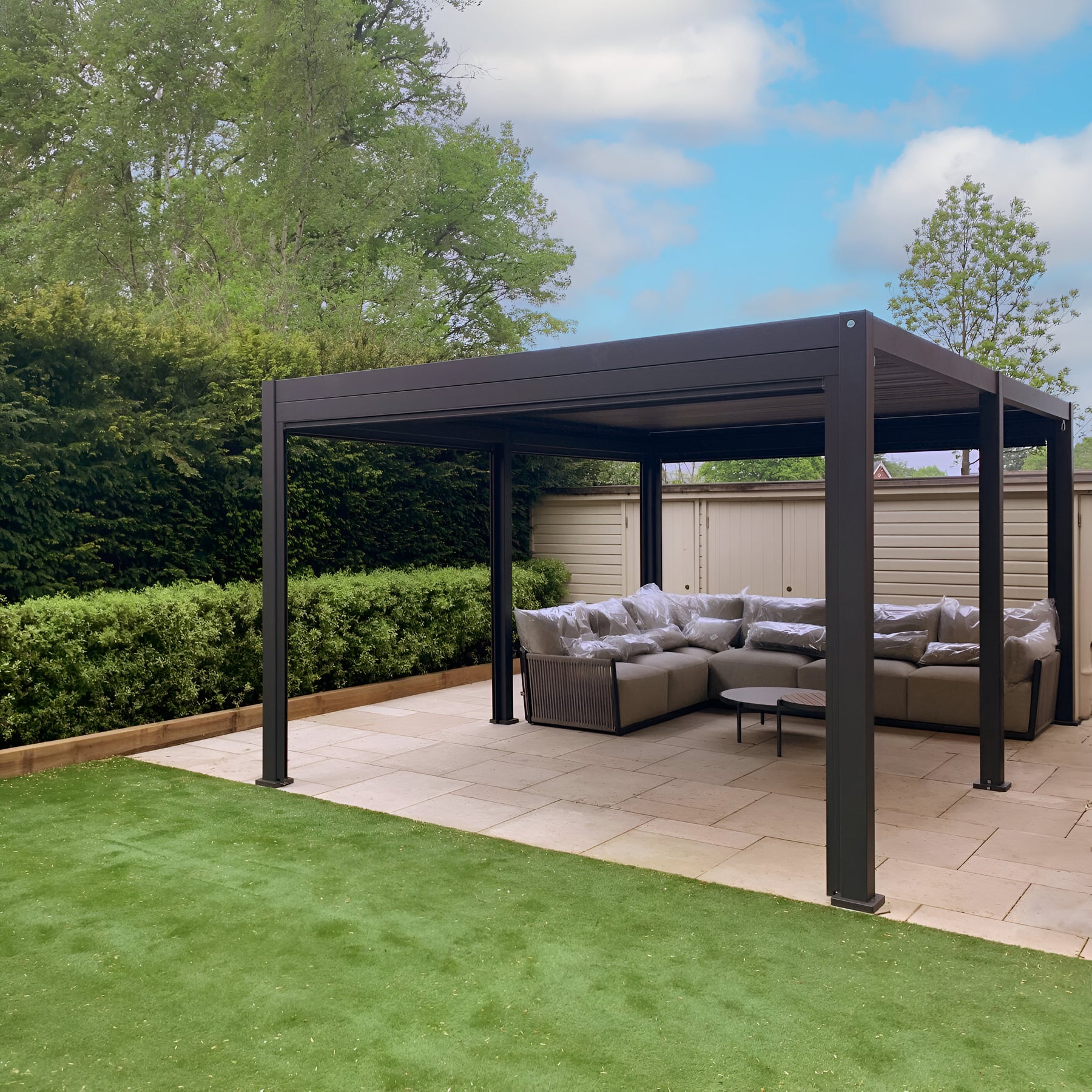
Everything you've ever wondered about pergolas - here is the answer!
Can a pergola be installed on a patio?
A patio is the most popular location for an aluminium pergola. Installing a beautiful pergola on your patio not only adds aesthetic appeal to the back of your house, but also provides shade and creates an inviting atmosphere for relaxation and entertainment. To install a pergola on your patio, you have several options.
One option is to attach the pergola to both the patio, and the back of your house. This wall mounting is generally optional, the patio fixing is not (to ensure stability).
Another popular option is to have a freestanding pergola specifically designed for patios. These freestanding structures are easy to assemble and you can place it anywhere on your patio.
Ultimately, most Aluminium Pergolas are designed with patio installation in mind, so it is very simple. It’s just a case of having suitable footings / a solid base underneath, and fixing the footplates at the bottom of the pergola legs into that.

Can a pergola be installed on a deck?
Can a pergola be installed on a deck? Absolutely!
One of the great things about Aluminium Pergolas is their versatility. They can be installed on various surfaces, including decks.
Whether you have a wooden or composite deck, you can easily add a pergola to enhance the beauty and functionality of your outdoor space. When it comes to installing a pergola on a deck, there are a few factors to consider.
First, you need to determine if your deck can support the weight of the pergola. Most decks are built to withstand additional weight, but it's always wise to consult with a professional if you're unsure. Aluminium is generally a better option than wood in these cases. You don't want your deck collapsing under the weight of your newly installed pergola!
Next, you'll need to decide what footings you’ll utilise for the pergola. No matter where they are installed, pergolas need proper footings for stability. Generally timber joists or concrete feet underneath the decking boards at the location of the pergola legs is the way to go.
Ask for a floorplan (we can provide these for any of our pergolas) - then map out the leg positioning and ensure you have something solid underneath to fix to. Then you’re good to go!

Can a pergola hold a swing?
This is a funny one, I guess I see the appeal!
The answer here is a classically unhelpful “it depends”. I think if you intend to hang a swing from your pergola, it is best to get manufacturer approval, so you know it won’t cause any damage to the pergola, or more importantly you / your children.
I would be tentative about hanging a swing from an aluminium pergola, the last thing you want to do is bend the frame. It might be more realistic with a wooden pergola, but again you’d just want to take it can support the load.

Can a pergola hold a hammock?
Very similar answer to the swing question above.
First and foremost, you'll want to make sure that the structure itself is sturdy enough to bear the weight of both the hammock and anyone who will be using it. This means ensuring that the posts are securely anchored in the ground and that any cross beams or rafters are strong enough to withstand the load.
If you are going to hang a hammock from a pergola, it's best to use heavy-duty hooks or carabiners designed for this purpose, making sure they're securely fastened into load-bearing points on both the pergola and your hammock itself. By taking these precautions and following proper installation guidelines, you can create an ideal oasis where you can unwind under your beautiful pergola while gently swaying in your cosy hammock.

Where to buy the wood to build your own pergola
If you're feeling adventurous and want to build your own pergola, one of the first things you'll need is the right wood. But where can you get it? Fear not, for there are plenty of options available to fulfill your DIY dreams.
One classic option is to head down to your local lumber yard or home improvement store. These will typically have a wide range of wood types and sizes available, allowing you to find the perfect fit for your pergola project.
You can browse through different options such as redwood, cedar, or pressure-treated pine, all of which have their own unique characteristics and durability. Another avenue worth exploring is online suppliers.
Don't forget about specialty woodworking stores either! If you're looking for more exotic or high-quality wood species like teak or mahogany, these specialized stores might be your best bet.

Which timber is best for a pergola?
When it comes to choosing the best timber for your pergola, there are a few factors to consider. One of the most popular choices is cedar wood, known for its natural resistance to rot and insects. Cedar also has a beautiful reddish-brown color that can enhance the overall aesthetic appeal of your pergola.
Another excellent option is redwood, which is known for its durability and strength. Redwood has a rich, deep color that adds warmth and charm to any outdoor space.
If you're looking for a more budget-friendly option, pressure-treated pine is worth considering. It's treated with chemicals to resist decay and provide long-lasting durability.
In addition to considering the type of wood, it's also important to think about the grade and quality of timber.
Higher-grade timbers will have fewer knots and imperfections, which can affect both the appearance and structural integrity of your pergola. Before making a decision, be sure to take into account your local climate and weather conditions.
Some types of wood are better suited for certain climates than others. For example, if you live in an area with high humidity or heavy rainfall, you may want to choose a timber that is naturally resistant to moisture such as cedar or redwood.
Ultimately, it's essential to choose a timber that suits your personal taste, budget, and specific needs for your pergola project. Research different options thoroughly, consult with experts if needed, and consider factors such as maintenance requirements and longevity when making your final decision on which timber is best for your pergola.

Are pergolas hurricane proof?
Are pergolas hurricane proof? Living in areas prone to hurricanes, it's natural to wonder if a pergola can withstand the wrath of Mother Nature.
While pergolas are undoubtedly sturdy structures, it's important to note that they are not designed to be entirely hurricane-proof. However, with some precautions and modifications, you can significantly enhance their resilience.
The best quality Aluminium Pergolas can withstand winds up to 120kmph, and some wooden structures even more.
Ultimately, you want to ensure that your pergola has been properly installed with proper footings, and when the wind is due to be high, make sure all blinds are stowed away, and that the roof louvres (if it has them) are adjusted to roughly a half turn. You want the least amount of surface area for the wind to pass through the louvres.

Can a pergola have a solid roof?
Of course. Sometimes these hardtop pergolas are called Gazebos, it is all much of a muchness really. You can certainly have a hard top roof on your pergola, but I would consider a louvered roof, for the wonderful flexibility and practicality.

How does a pergola provide shade?
Pergolas are not just decorative structures; they also provide a perfect spot to relax and enjoy some shade. But have you ever wondered how exactly a pergola manages to provide shade? Let's delve into the details.
One of the main factors that contribute to the shading capabilities of a pergola is its open, lattice-like roof design. Unlike solid roofs, which block out sunlight completely, pergolas feature an interwoven pattern of slats or beams.
These slats create partial shade by allowing some sunlight to filter through while blocking the direct intensity of the sun's rays. Another way a pergola provides shade is through the use of climbing plants such as vines or creepers.
If you opt for a louvered roof you can even customise your level of shading, rotating the roof louvres to adjust how much sun is allowed into your pergola

What is the point of a pergola?
A pergola, my friend, is not just a pointless structure for the aesthetic, well some are. But most actually offer a great deal of practicality.
The idea is to spend more time enjoying your garden. The right pergola (ideally an aluminium pergola with a louvered roof) - can protect you from sun, wind, rain, cold and more. Accessorise with blinds, heaters and ensure you’ve got your louvered roof, and it will be a haven all year round.

Where did pergolas originate from?
Let me transport you back in time to ancient Egypt. Yes, you heard it right - pergolas can be traced all the way back to the land of pharaohs and pyramids!
In those days, pergolas were not just decorative features; they served a practical purpose of providing shade from the scorching desert sun. The Egyptians were clever in their design, using materials like palm fronds and woven reeds to create a roof-like structure that shielded them from the intense heat while still allowing for air circulation.
They truly understood how to combine form and function seamlessly. As time went on and civilizations evolved, pergola-style structures made their way into other parts of the world.
The Greeks, with their passion for outdoor living and appreciation for beauty, embraced the concept of pergolas wholeheartedly. They integrated them into their gardens and public spaces with gusto!
These Greek variations were often adorned with climbing vines like wisteria or grapevines that added a touch of natural allure. Imagine strolling through an ancient Greek garden surrounded by fragrant flowers and lush greenery while basking in the dappled sunlight filtering through a pergola overhead - it's enough to make one yearn for simpler times!
Moving forward in history, we find ourselves in Renaissance Italy where pergolas continued to thrive as an integral part of garden design. Italian architects embraced this architectural marvel as an essential element in creating picturesque landscapes that celebrated nature's beauty.
It was during this period that pergolas began incorporating more ornate details such as intricate carvings or trellises adorned with climbing roses or jasmine. The Italians truly transformed these structures into works of art that blended harmoniously with their surroundings.
I think the ancient Greeks and Egyptians would be delighted that you and your loved ones can enjoy a cold glass of rose and a BBQ feast in the ultimate way, all thanks to their ingenuity.

Other content you'll love:
Surely you don’t have more questions?
Well if you do, we’d love to hear from you.
Email: sales@woodlarkgardenluxury.co.uk
Phone: 020 3835 8311


